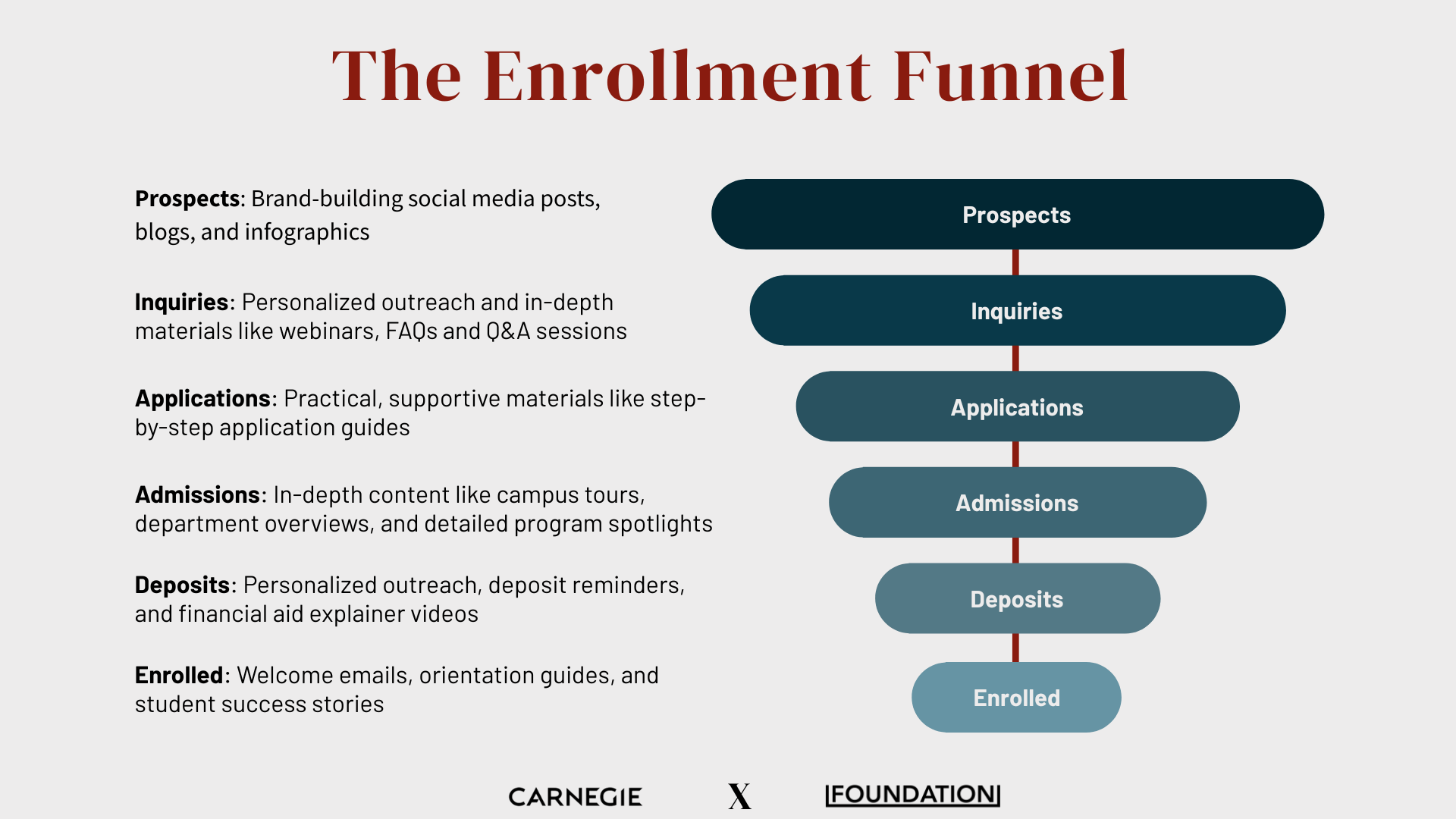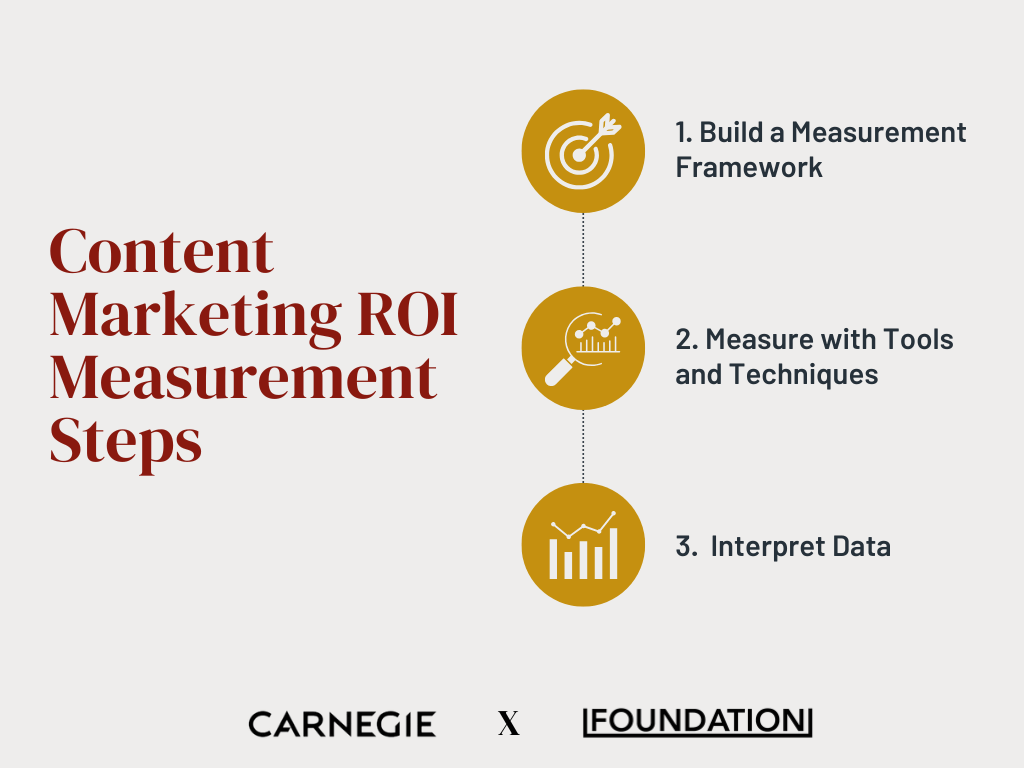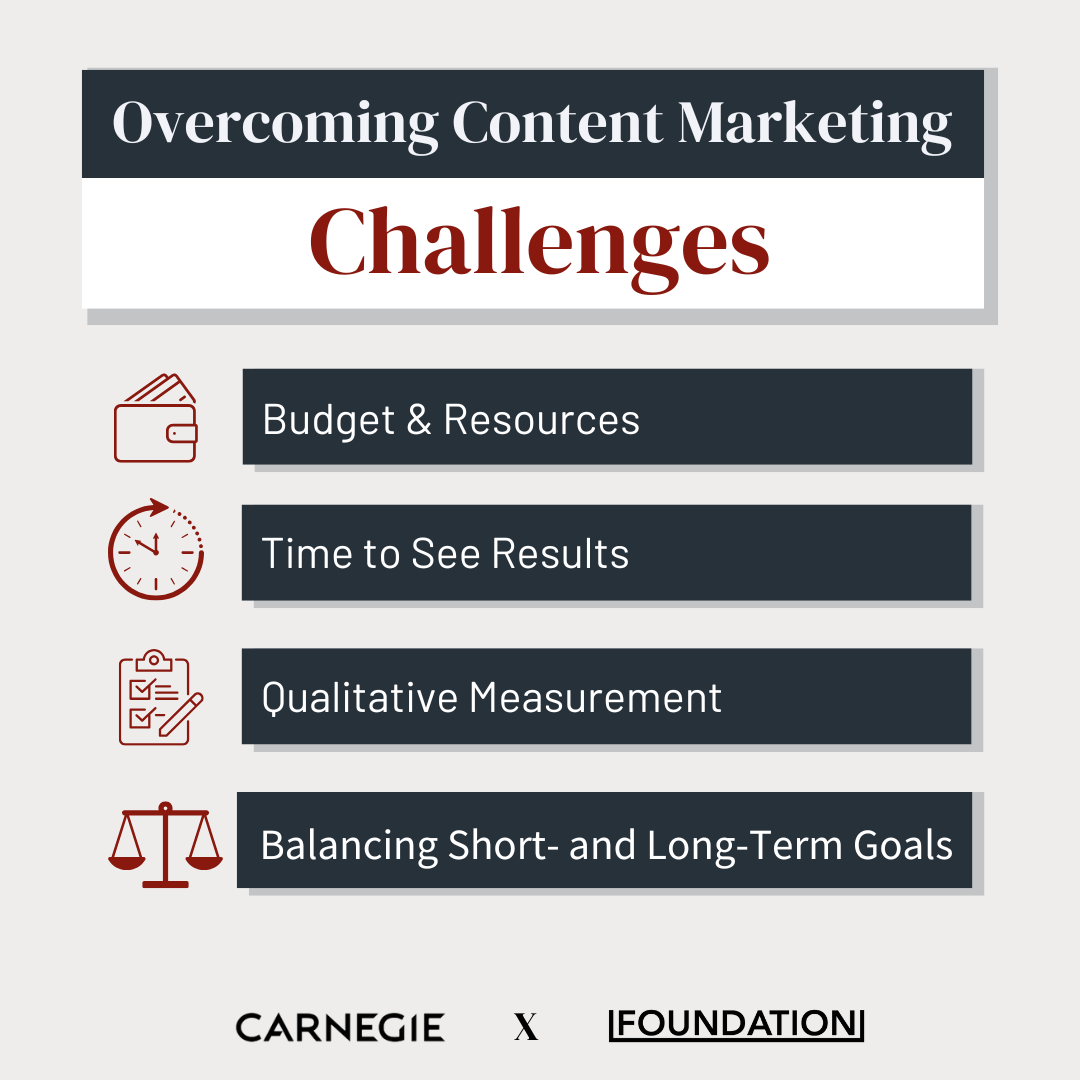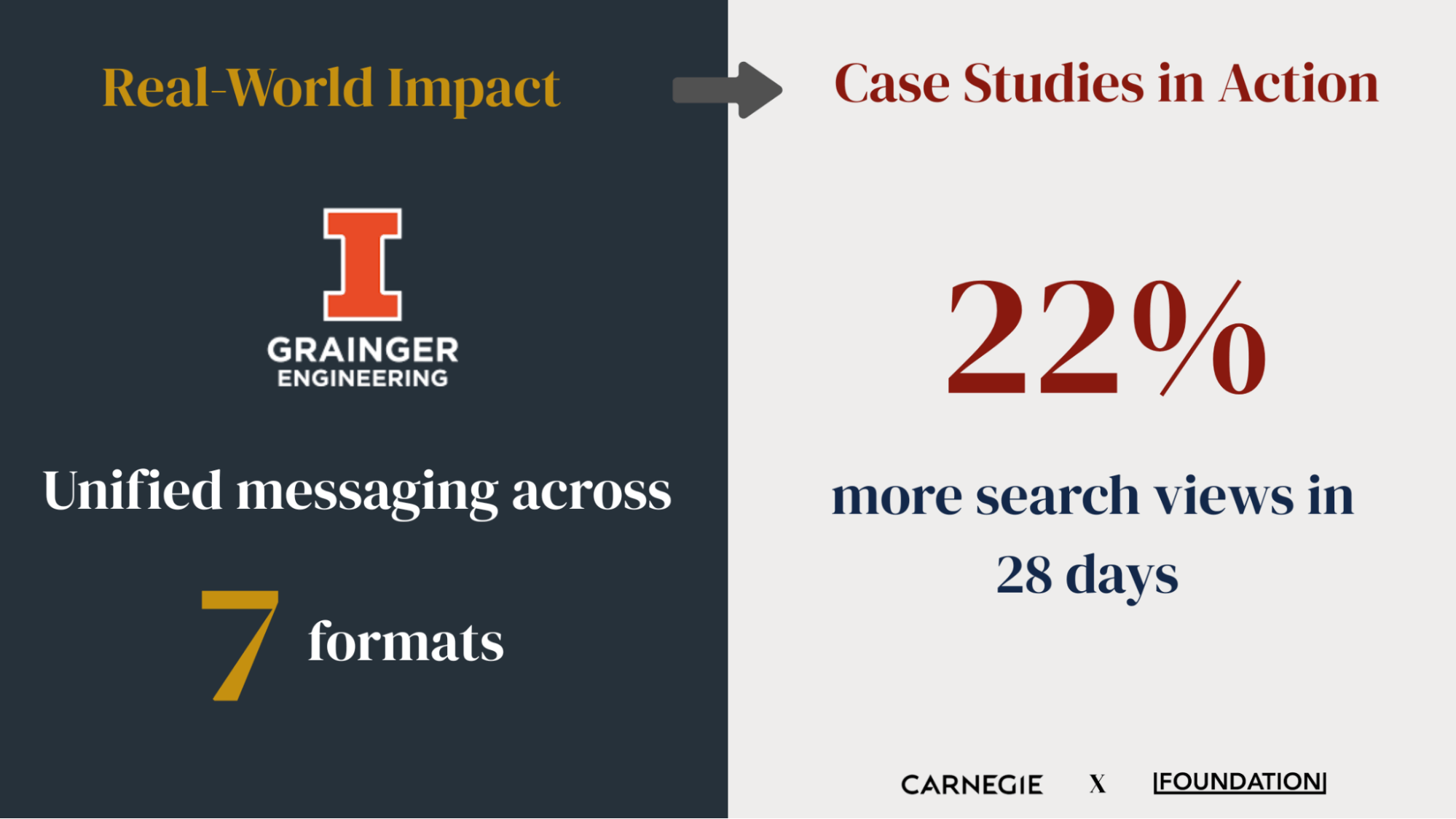 May 22, 2025
Persona
May 22, 2025
Persona
Table of Contents
-
- Understanding Content Marketing ROI
- Why Content Marketing ROI Matters for Universities
- How to Measure Content Marketing ROI in Higher Ed
- Common Content Marketing ROI Challenges
- How Two Universities Got ROI on Content Marketing
- Future Trends in Content Marketing ROI for Higher Education
- Transform Your Marketing, Transform Your Future
Content marketing has become a strategic necessity for universities.
Whether you’re aiming to boost enrollment, shape perception, or build long-term brand equity, the question isn’t whether you should invest in content—it’s how will you prove it works?
This article breaks down how higher ed marketers can define, track, and communicate content ROI. We’ll cover the most relevant metrics, common measurement pitfalls, and two case studies that show how it’s being done in the real world.
Understanding Content Marketing ROI
Content marketing ROI shows the value of investing in content that attracts students and builds your brand. It covers hard metrics like traffic conversions, and enrollment numbers, and softer outcomes, like reputation and connections with students.
Measuring ROI in higher ed isn’t always straightforward. The student decision-making process takes time and involves many voices—students, parents, faculty, and alumni. That’s why it’s important to track both immediate metrics, like click-through rates, and long-term indicators, like enrollment yield and alumni involvement over time.
Key performance indicators (KPIs) for higher education content marketing typically include:
- Website Traffic & Engagement: Tracking page views, time on site, and interaction rates signals how effectively content captures interest.
- Lead Conversion: Monitoring inquiry and application rates provides insight into how well content motivates potential students to take the next step.
- Enrollment & Yield Rates: Measuring how many engaged prospects eventually enroll helps evaluate the impact on the bottom line.
- Brand Metrics: Surveys and sentiment analysis reflect qualitative aspects, like increased trust and improved institutional reputation.
WANT TO LEARN ABOUT OUR CONTENT MARKETING OFFERING? GET IN TOUCH.
Why Content Marketing ROI Matters for Universities
Content marketing ROI helps universities make a strong case for marketing spend by connecting efforts to both enrollment and brand growth. When results are measurable, it’s easier to justify budgets and secure long-term investment.
The right content, when it’s targeted, high quality, and relevant, builds trust with prospective students and helps your institution stand out.
Strong content marketing drives engagement at every stage of the enrollment funnel, turning awareness into inquiries, applications, and ultimately, enrollments. Personalized content improves conversions and deepens connections with prospective students. When done well, this approach delivers immediate results and sets the stage for long-term growth.
Here are some examples of the content types that can succeed at each stage of the enrollment funnel:

Understanding ROI also helps institutions refine their strategies over time.
Regular measurement and analysis identify which content types and distribution channels perform best, allowing for continuous optimization. As higher education increasingly relies on data-driven decisions, proving the impact of content marketing aligns marketing efforts with broader institutional objectives.
Key Components That Drive Content Marketing ROI
Several core factors work together to drive content marketing ROI:
High quality, relevant content matters. Articles, videos, and social posts need to answer important questions and highlight what makes your college or university unique. Likewise, compelling stories create more memorable and engaging experiences for prospective students.
The right distribution channels extend your reach. Sharing content across your website, social media, email, and webinars helps you connect with various audiences online, from high school students to working professionals.
Personalization strengthens connections with specific audiences. Content tailored to different groups like undergraduates, graduates or international students makes each audience feel understood. With data and feedback, you can customize messages to meet each group’s specific needs.
Tracking performance metrics, like website visits, social media interactions, and inquiry/application numbers, helps you refine your strategy in real time.
Together, these components—quality content, smart distribution, targeted personalization, and consistent tracking—form the foundation for strong content marketing ROI.
How to Measure Content Marketing ROI in Higher Ed
Measuring and analyzing content marketing performance helps universities understand which strategies drive engagement, inform decisions about budget allocation, and ultimately enhance enrollment outcomes.
Here’s how to build a strong measurement system, pick the right tools, and use your data to drive smart decisions.

Step 1: Set Up a Measurement Framework
Begin by defining clear, specific goals for your content marketing efforts. Ask yourself what you want to achieve. Are you looking for more website visits, higher inquiry rates, or an increase in student enrollments? Document these goals so your team understands the targets.
With your goals defined, choose the key metrics that reflect progress toward those goals.
Key Metrics to Track:
- Website Traffic: Number of visitors, page views, and time spent on site.
- Social Media Engagement: Likes, shares, comments, and reach.
- Email Performance: Open rates, click-through rates, and responses.
- Inquiry and Enrollment Rates: Number of inquiries initiated, applications submitted, and eventual enrollments.
Link each metric to a specific enrollment step. For example, connect website visits to awareness, email clicks with conversion, and so on.
Step 2: Use the Right Tools and Techniques
Once you’ve determined what to measure, you’ll need the proper tools to collect this data.
Use a suite of digital tools to gather accurate and timely data points:
- Google Analytics: Monitor site traffic, identify popular content, and analyze visitor behavior.
- Social Media Insights: Use platform-specific analytics to track which posts gain the most traction.
- Email Marketing Software: Measure open rates, click-throughs, and other engagement metrics.
- CRM Systems: Integrate customer relationship management tools to follow prospects through the enrollment funnel.
Step 3: Make Sense of the Data
With data collection tools in place, the final step is analysis and action.
Review your data on a regular schedule (e.g., weekly, monthly, or quarterly). During these reviews:
- Hold team meetings to discuss recent performance.
- Identify trends, such as spikes in engagement or drops in conversion rates.
Next, make actionable changes based on findings:
- Adjust your content topics or formats if certain posts perform poorly.
- Optimize call-to-action buttons if conversion rates seem lower than expected.
- Test different headlines, imagery, or email subject lines using A/B testing.
Finally, create simple reports and share these insights with marketing and admissions teams to support collaboration and improvement.
Following these steps builds a robust measurement and analysis framework that leads to smarter content marketing investments and better enrollment outcomes.
Common Content Marketing ROI Challenges
Even with the best measurement systems in place, universities often encounter roadblocks when calculating their true content marketing ROI:

Budget and Resource Limitations
The first major hurdle many institutions face is financial constraint. Tight budgets mean every investment must deliver a measurable impact. When funds are scarce, focus on high-impact content that connects directly with prospective students and aligns with enrollment goals.
For example, targeted social media campaigns that drive inquiries may yield higher returns than posting broad, unfocused content to boost engagement.
Beyond money, managing staff time is a significant challenge. Streamline production by identifying content types that consistently outperform others and consider automating tasks like social media scheduling or email marketing. Cross-training team members and outsourcing specific tasks can also balance workloads while maintaining ROI.
Time to See Results
Another common hurdle stems from the timing of outcomes. Higher education marketing involves long decision-making timelines where prospective students can take months to move from awareness to enrollment.
With that in mind, set realistic, long-term goals and track progress over extended periods. Use a mix of short-term indicators, like inquiry rates, and long-term metrics, like enrollment numbers, to gauge success.
To accommodate this extended timeline, plan phased strategies that allow for continuous engagement. Regularly review and adjust your tactics based on the cumulative progress, and be patient as you build a sustained pipeline of prospective students.
Difficulty Measuring Qualitative Outcomes
Brand trust and reputation improvements aren’t easily measured by clicks or views. These qualitative outcomes require a more nuanced approach. Use simple surveys or feedback forms to gather insights about how your content shapes perceptions among prospective students, alumni, and other stakeholders.
To go even deeper, gather testimonials and monitor social media sentiment. These qualitative insights may be less concrete than numbers, but they’re just as important for understanding your content’s full impact.
Balancing Short-Term Wins and Long-Term Goals
Quick wins like viral posts may bring short-term gains, but sustainable success comes from long-term relationship building and brand strategy. Test and refine your strategy through regular A/B testing and iterative adjustments. This approach lets you celebrate short-term wins while advancing broader, long-term objectives.
Planning for these challenges—smart resource allocation, clear goal-setting, qualitative and quantitative outcome tracking, and balancing immediate and long-term goals—helps universities build content marketing strategies that drive real results over time.
Let’s examine two universities that have achieved measurable returns with content marketing to see how this works in the real world.
How Two Universities Got ROI on Content Marketing
Case studies show how well-executed content marketing can boost visibility, improve engagement, and increase enrollments.
Below are two detailed examples of how strategic partnerships have transformed marketing efforts at higher education institutions.

Grainger College of Engineering – Sharing a Bold Story
The University of Illinois Urbana-Champaign’s Grainger College of Engineering set out to unify its brand and amplify its influential story. Carnegie began by boosting the college’s visibility in search results through targeted SEO efforts.
As leadership acknowledged the importance of a cohesive and bold brand, Carnegie expanded its role to include a comprehensive brand strategy engagement. Internal workshops uncovered the College’s unique personality, while competitor analysis and external market research identified differentiation opportunities. This collaboration created a striking campaign concept that embraced the College’s industrious spirit.
Creative development produced a full brand video and various multimedia assets, including social media clips and landing pages that showcased student achievements. The initiative provided Grainger with a robust framework for brand expression that continues to enhance its reputation nationally and globally.
University of LaVerne College of Law – Optimized Visibility Through SEO
The University of LaVerne College of Law struggled with low search engine visibility, which limited its ability to attract prospective students. Carnegie conducted a comprehensive technical audit that uncovered over 25,000 issues impacting site performance, from duplicate content and broken links to problematic metadata.
Following the audit, a strategic content optimization plan revamped existing pages and created new ones focused on high-value keywords related to its Juris Doctor and dual degree programs. In addition, Carnegie enhanced the College’s local digital presence by optimizing its Google Business Profile, updating key details such as photos, service area, and metadata while implementing UTM tracking to monitor engagement.
These efforts significantly improved organic search rankings, drawing more qualified traffic to the website and offering a better overall user experience. The dramatic boost in visibility strengthened connections with prospective students and positively impacted enrollment outcomes.
These examples show that focused and collaborative approaches, whether refining brand narratives or addressing technical SEO challenges, can substantially improve digital engagement and enrollment growth.
Future Trends in Content Marketing ROI for Higher Education
The future of content marketing in higher education promises exciting innovations and shifts in how return on investment is measured. Digital trends like AI-driven content personalization, augmented reality campus tours, and virtual influencers are reshaping marketing.
These tools offer personalized experiences that make campus life and academic programs more relatable and engaging. For example, AI can tailor content to a student’s browsing habits, while augmented reality tours allow virtual exploration of campuses from anywhere in the world.
At the same time, the evolution of metrics and data analytics is transforming ROI tracking. In the coming years, expect greater reliance on sophisticated data tools that provide real-time reporting and deeper insights into student engagement.
New key performance indicators (KPIs), such as content interaction depth, personalized engagement scores, and conversion quality metrics, will help institutions measure the true impact of their digital efforts.
To stay competitive, universities need to adapt their marketing strategies to shifting student behaviors and tech trends. As student expectations evolve with technology use, institutions must remain agile and proactive, continuously testing new tools and approaches. Universities that embrace innovation will best capture tomorrow’s students and drive meaningful enrollment growth.
WANT TO LEARN ABOUT OUR CONTENT MARKETING OFFERING? GET IN TOUCH.
Transform Your Marketing, Transform Your Future
Done right, content marketing boosts traffic, increases conversions, and strengthens yield, ultimately building a brand that connects with students, parents, and stakeholders.
Now is the time to dig in: set clear goals, track your data closely, and refine your strategy with purpose.
Ready to get started?
Let’s build a marketing strategy together.
Get in touch with our higher education marketing experts today.
With a bold, agile, and innovative approach to digital marketing, you can position your institution to lead the future of education.
